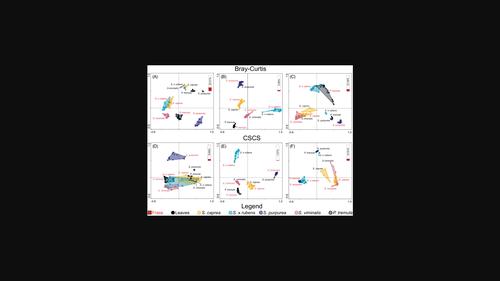当前位置:
X-MOL 学术
›
Physiol. Entomol.
›
论文详情
Our official English website, www.x-mol.net, welcomes your feedback! (Note: you will need to create a separate account there.)
Different fates of metabolites and small variation in chemical composition characterise frass chemistry in a specialist caterpillar
Physiological Entomology ( IF 1.5 ) Pub Date : 2024-01-29 , DOI: 10.1111/phen.12429 Carlo L. Seifert 1 , Martin Moos 2 , Martin Volf 2, 3
Physiological Entomology ( IF 1.5 ) Pub Date : 2024-01-29 , DOI: 10.1111/phen.12429 Carlo L. Seifert 1 , Martin Moos 2 , Martin Volf 2, 3
Affiliation

|
Specialist and generalist insect herbivores evolved different strategies to process host-plant metabolites. We explored frass composition in Laothoe populi (L.) caterpillars (Lepidoptera: Sphingidae), a specialist moth species that is closely associated with plants of the Salicaceae (Mirb.) family. We fed the caterpillars with leaves from three willow species (Salix caprea L., S. purpurea L. and S. viminalis L.), one willow hybrid (S. x rubens Schrank) and one poplar species (Populus tremula L.). Using untargeted metabolomics, we compared the chemical composition and variation among leaf and frass samples. We quantified the chemical variation using either a simple index based on the presence and concentration of metabolites (i.e., Bray-Curtis) or an index that additionally accounts for chemical structural-compositional similarity (CSCS) among metabolites. Due to the high degree of dietary specialisation, we expected low host-specific variation in frass composition among the caterpillars. Based on literature, we further hypothesised that ingested salicinoids will be largely modified in the caterpillar gut while flavonoids will be often passively excreted. Finally, we compared chemical variation among the samples when quantified with Bray-Curtis or CSCS metrics. As expected, we found relatively low host-specific variation in the chemical composition of caterpillar frass. Our results further suggest that flavonoids were largely passively excreted by the caterpillars, while salicinoids were metabolised in the gut. Finally, we found that chemical composition measures based on Bray-Curtis overestimated the differences in chemical composition between frass and leaves, suggesting that for these type of samples CSCS measures are better suited to reflect metabolic changes more realistically.
中文翻译:

代谢物的不同命运和化学成分的微小变化是专业毛毛虫粪便化学的特征
专科和通才昆虫食草动物进化出不同的策略来处理宿主植物代谢物。我们探索了老花毛毛虫(鳞翅目:天蛾科)的苔藓成分,这是一种与杨柳科(Mirb.)家族植物密切相关的特殊蛾类。我们用三种柳树品种(Salix caprea L.、S. purpurea L. 和S. viminalis L.)、一种柳树杂交种(S. x rubens Schrank)和一种杨树品种(Populus tremula L.)的叶子喂养毛毛虫。使用非靶向代谢组学,我们比较了叶子和苔藓样品的化学成分和变化。我们使用基于代谢物的存在和浓度的简单指数(即 Bray-Curtis)或另外考虑代谢物之间化学结构组成相似性(CSCS)的指数来量化化学变化。由于饮食的高度专业化,我们预计毛虫之间的粪便成分的宿主特异性差异较小。根据文献,我们进一步假设摄入的水杨酸类化合物在毛毛虫肠道中会发生很大程度的改变,而黄酮类化合物通常会被动排出体外。最后,我们比较了使用 Bray-Curtis 或 CSCS 指标进行量化时样品之间的化学变化。正如预期的那样,我们发现毛毛虫的化学成分的宿主特异性变化相对较低。我们的结果进一步表明,黄酮类化合物大部分是由毛毛虫被动排泄的,而水杨酸类化合物则在肠道中代谢。最后,我们发现基于 Bray-Curtis 的化学成分测量高估了苔藓和叶子之间化学成分的差异,这表明对于这些类型的样品,CSCS 测量更适合更真实地反映代谢变化。
更新日期:2024-01-31
中文翻译:

代谢物的不同命运和化学成分的微小变化是专业毛毛虫粪便化学的特征
专科和通才昆虫食草动物进化出不同的策略来处理宿主植物代谢物。我们探索了老花毛毛虫(鳞翅目:天蛾科)的苔藓成分,这是一种与杨柳科(Mirb.)家族植物密切相关的特殊蛾类。我们用三种柳树品种(Salix caprea L.、S. purpurea L. 和S. viminalis L.)、一种柳树杂交种(S. x rubens Schrank)和一种杨树品种(Populus tremula L.)的叶子喂养毛毛虫。使用非靶向代谢组学,我们比较了叶子和苔藓样品的化学成分和变化。我们使用基于代谢物的存在和浓度的简单指数(即 Bray-Curtis)或另外考虑代谢物之间化学结构组成相似性(CSCS)的指数来量化化学变化。由于饮食的高度专业化,我们预计毛虫之间的粪便成分的宿主特异性差异较小。根据文献,我们进一步假设摄入的水杨酸类化合物在毛毛虫肠道中会发生很大程度的改变,而黄酮类化合物通常会被动排出体外。最后,我们比较了使用 Bray-Curtis 或 CSCS 指标进行量化时样品之间的化学变化。正如预期的那样,我们发现毛毛虫的化学成分的宿主特异性变化相对较低。我们的结果进一步表明,黄酮类化合物大部分是由毛毛虫被动排泄的,而水杨酸类化合物则在肠道中代谢。最后,我们发现基于 Bray-Curtis 的化学成分测量高估了苔藓和叶子之间化学成分的差异,这表明对于这些类型的样品,CSCS 测量更适合更真实地反映代谢变化。



























 京公网安备 11010802027423号
京公网安备 11010802027423号